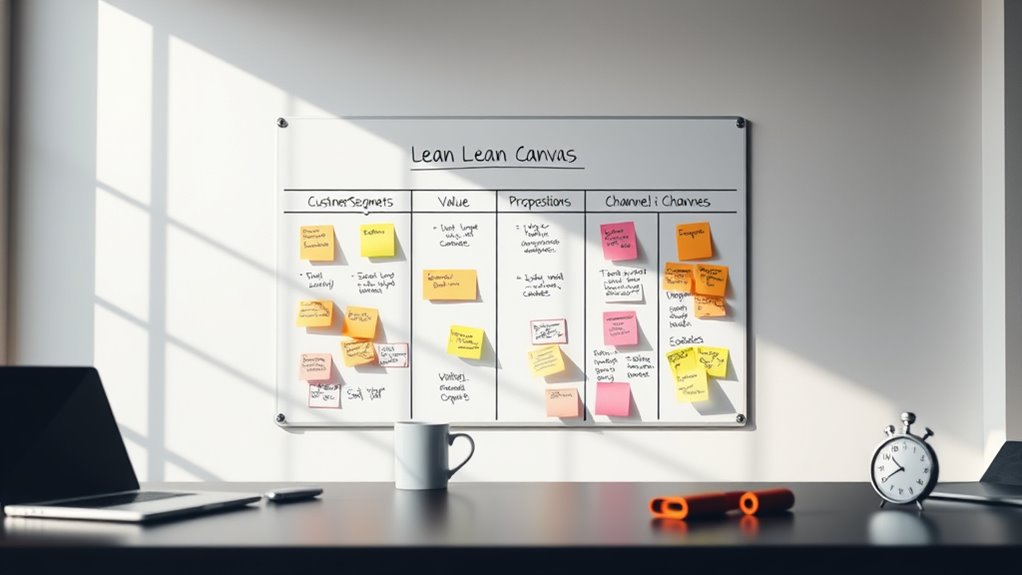The Lean Canvas helps you map out your startup ideas quickly—often in just 20 minutes—by focusing on core business aspects. It guides you to identify your target customer segments, validate assumptions through simple experiments, and avoid wasting time on untested ideas. Using this visual tool, you can clarify your model and reduce risks early on. Keep exploring to discover how mastering this process can boost your chances of success.
Key Takeaways
- The Lean Canvas provides a quick, visual framework to map startup ideas within 20 minutes.
- It helps identify and validate core customer segments through rapid experiments like surveys and interviews.
- Using the Canvas accelerates market validation, reducing risk by testing assumptions early.
- It transforms vague concepts into actionable insights, clarifying target customers and value propositions.
- The process promotes iterative learning, enabling startups to refine their ideas efficiently before scaling.

Have you ever struggled to organize your business idea clearly and efficiently? It’s a common challenge, especially when you’re trying to move quickly and avoid wasting time on assumptions that may not hold up. That’s where the Lean Canvas comes in. It’s a simple, visual tool designed to help you map out your startup idea in just 20 minutes, focusing on the core aspects of your business. One of the most *essential* parts of this process is market validation and understanding your customer segments. Without clarity on who your customers are and whether there’s a real demand for your product, your idea can flounder before it even gets off the ground.
The Lean Canvas encourages you to pinpoint your customer segments early on. You need to ask yourself: who are the people most likely to buy or use what I’m offering? By clearly defining these groups, you can tailor your messaging and product features to meet their specific needs. The tool pushes you to think about different customer segments separately rather than lumping everyone into one broad category, which often leads to ineffective marketing and product misalignment. Once you identify your target groups, you can test your assumptions about these segments quickly and efficiently. This is where market validation becomes *vital*. Instead of building a full-fledged product and hoping it sticks, you test your ideas with real potential customers early on. Ask questions, gather feedback, and adjust your approach based on what you learn.
Identify your target customer groups early and validate assumptions to ensure your startup’s success.
Using the Lean Canvas, you can map out your hypotheses about your customer segments and then seek validation through quick experiments like surveys, interviews, or landing pages. The goal is to find out if your assumptions about their problems, desires, and willingness to pay are accurate. If they aren’t, you pivot — refining your customer segments or even your entire business idea — instead of investing time and resources into something that might not succeed. This iterative process saves you from costly mistakes and helps you focus on what truly matters: delivering value to the right audience. Additionally, understanding the horsepower of electric dirt bikes can help validate your target market if you’re considering a niche within off-road enthusiasts.
In just 20 minutes, the Lean Canvas helps you clarify your market validation strategy by forcing you to think critically about your customer segments. It transforms vague ideas into actionable insights, allowing you to move forward with confidence. By understanding who your customers are and validating your assumptions early, you leverage market research techniques to gather more precise data. This process is similar to exploring different product features that resonate well with your target audience. You set a strong foundation for your startup. The Lean Canvas isn’t just about planning; it’s about testing, learning, and adapting swiftly, ensuring your idea resonates with the right people before you scale.
Frequently Asked Questions
Can the Lean Canvas Be Adapted for Non-Startup Projects?
You can definitely adapt the Lean Canvas for non-startup projects due to its application versatility. The key is customizing its sections to fit your project’s unique goals, challenges, and stakeholders. By modifying the template, you clarify your ideas, identify risks, and plan effectively, regardless of whether you’re working on a social initiative, internal process, or creative endeavor. This flexibility makes it a powerful tool for various project types beyond startups.
How Often Should I Update My Lean Canvas?
You might think you only need to update your Lean Canvas once and forget about it, but that’s like trying to hit a moving target with a bow and arrow! The key is to match your iteration frequency with your project’s pace. Regular updates—say, every few weeks or after major milestones—keep your business aligned with reality. Don’t wait too long; timely update timing guarantees your canvas stays sharp and relevant.
Is the Lean Canvas Suitable for Team Collaboration?
Yes, the Lean Canvas is great for team collaboration. It encourages team brainstorming and helps everyone share their ideas openly. Using it for collaborative planning allows your team to quickly visualize the business model, identify gaps, and align on goals. By working together on the canvas, you foster a more cohesive understanding and make faster, more informed decisions. It’s an effective tool for engaging your entire team in the planning process.
What Tools Can Help Create a Lean Canvas Digitally?
Imagine building your ideas on a digital canvas—what tools can you use? Digital tools like Miro, Canva, and Figma stand out, offering intuitive interfaces for creating and sharing Lean Canvases effortlessly. Collaboration platforms such as Google Jamboard or Notion also facilitate real-time teamwork. These tools help you visualize, iterate, and communicate your business model seamlessly, making collaboration smoother and more dynamic, no matter where your team is located.
How Does the Lean Canvas Differ From Business Model Canvas?
You’ll find that the Lean Canvas differs from the Business Model Canvas mainly in focus. It emphasizes market validation and a clear value proposition, helping you quickly test assumptions. While the Business Model Canvas covers broader aspects like partnerships and resources, the Lean Canvas zeroes in on customer problems, solutions, and unique value, making it ideal for startups aiming to validate their ideas rapidly and efficiently.
Conclusion
By mastering the Lean Canvas, you can validate ideas quickly—studies show startups that test their assumptions early have a 30% higher success rate. In just 20 minutes, you’ll map out your business model, identify potential pitfalls, and focus on what truly matters. This approach saves time, reduces risk, and accelerates growth. So, don’t wait—start sketching your Lean Canvas today and turn your ideas into actionable plans faster than ever before.










